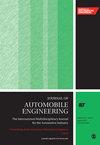二冲程无杆火花点火对置活塞发动机活塞形状对缸内气体流动、燃料-装料混合和燃烧特性影响的计算分析
IF 1.5
4区 工程技术
Q3 ENGINEERING, MECHANICAL
Proceedings of the Institution of Mechanical Engineers Part D-Journal of Automobile Engineering
Pub Date : 2024-07-24
DOI:10.1177/09544070241264087
引用次数: 0
摘要
与传统的缸内直喷火花点火发动机相比,二冲程对置活塞发动机的侧喷和侧火花点火特性增加了点火内核偏移和火焰传播距离。提高火焰传播速度可以在一定程度上解决火花塞不集中布置带来的弊端。燃烧室结构对气体流动、燃料与充填物混合和燃烧特性起着至关重要的作用。因此,本研究设计了三种活塞并进行了比较分析。结果表明薄饼活塞因其简单平滑的球形圆弧结构,有利于保持进气漩涡强度。凹坑和凹坑导向活塞的漩涡强度明显降低,而翻滚强度能很好地保持。与薄饼活塞和凹坑导向活塞相比,凹坑活塞的平均 TKE 增加了约 25%,且在火花正时分布更为集中。薄饼活塞的清除性能最好,与坑式活塞相比,残余废气比降低了 2.1%,新鲜空气损失降低了 3.3%。在火花定时时可以形成稳定的点火核心,但三种活塞的火焰传播过程存在显著差异。与凹坑导向活塞相比,凹坑活塞的指示热效率降低了 0.3%,但燃烧持续时间缩短了 13.1%,从而降低了爆震倾向。本文章由计算机程序翻译,如有差异,请以英文原文为准。
Computational analysis of piston shape effects on in-cylinder gas flow, fuel-charge mixing, and combustion characteristics in a two-stroke rod-less spark ignition opposed-pistons engine
Compared with the traditional in-cylinder direct-injection spark ignition engine, the side-injection and side-spark-ignition characteristics of the two-stroke opposed-piston engine increase the ignition kernel offset and flame propagation distance. Increasing the flame propagation speed can to some extent solve the drawbacks caused by the non-central arrangement of spark plugs. The combustion chamber structure plays a crucial role in gas flow, fuel-charge mixing, and combustion characteristics. Therefore, three pistons were designed and comparatively analyzed in this study. The results show that: The pancake piston is beneficial to maintaining the intake swirl strength due to its simple and smooth spherical arc structure. The swirl strength of the pit and pit-guided piston decreases obviously, and the tumble strength can be maintained well. Compared to pancake and pit-guided pistons, the average TKE for the pit piston increased by approximately 25%, with a more concentrated distribution at the spark timing. The pancake piston exhibits the best scavenging performance, reducing the residual exhaust gas ratio by 2.1% and fresh air loss by 3.3% to the pit piston. A stable ignition core can be formed at the spark timing, but significant differences are observed in the flame propagation process for three pistons. Compared to the pit-guided piston, the pit piston has a 0.3% decrease in the indicated thermal efficiency, but a 13.1% decrease in combustion duration, which reduces knock tendency.
求助全文
通过发布文献求助,成功后即可免费获取论文全文。
去求助
来源期刊

CiteScore
4.40
自引率
17.60%
发文量
263
审稿时长
3.5 months
期刊介绍:
The Journal of Automobile Engineering is an established, high quality multi-disciplinary journal which publishes the very best peer-reviewed science and engineering in the field.
 求助内容:
求助内容: 应助结果提醒方式:
应助结果提醒方式:


